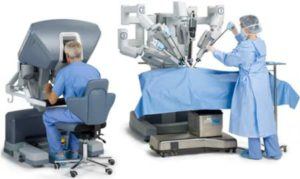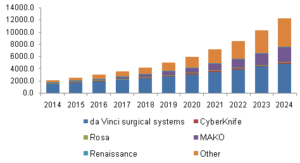da Vinci Xi – Surgical System: Advancement of minimally invasive surgery

Application of virtual reality in medical surgical practice
A traditional surgical operations has been cutting tissues of the patient’s body and exposing the affected part, resulting higher physical load. An advancement process of the surgery has enabled minimizing the exposure of the affected part, called “minimally invasive surgery”. Intuitive Surgical is a NASDAQ listed company focused on minimally invasive robotic-assisted surgery. The company has developed a product called Da Vinci Surgical System (DVSS), a surgical robotics with 3D virtual reality vision system which provides high visibility in minimally invasive surgery where physicians cannot physically see the affected area. The technology is the first product in the category approved for clinical use by the Food and Drug Administration in 2000.
Introduction of DVSS
VR application for DVSS
Value creation
DVSS enhances surgeons’ capability to operate with enhanced vision, precision and control, enforced by its VR vision system, wide range of motion of arms, and hand movement correction system etc. The technology benefits patients as it enables difficult operation and minimizes damage of patients’ body. Also, since DVSS has motion correction system, it enhanced safety of the surgery, minimizing human error. To the hospital, DVSS provides shorter duration of patients’ hospitalization due to less physical load which results in the improvement of efficiency of asset turnover.
However, some study shows that even though DVSS proves its efficacy of the surgery due to the quick recovery of patients’ body and short hospitalization, DVSS may results in the longer surgical hours. However it seems that the longer surgical hours compared to the traditional open surgery is inevitable due to the complexity of the operation. There is a clear trade-off but the revenue growth of the company implies the net advantage and strong demand of DVSS.
Value capture
Intuitive Surgical captures the value through“razor/razor blade” model. It sells DVSS to a hospital around $1.5mn per robot. Also it captures additional value from annual maintenance which ranges between $100,000 and $170,000 per year and sales of ancillary instruments and accessories from $700 to $3,200 per procedure. Revenue growth of hardware sales is around 5% but the sales growth of Instruments and accessories is around 15% and this recurring revenue stream consists of 75% of the company’s revenue, contributing the stability of the company. The company enjoys healthy operating margin of around 30%, thanks to the dominant position in the market and high switching cost due to the needs of user training and high upfront installment cost of the products.
North America surgical robot market share, by product, 2014 – 2024
Source: Grand View Research
Future potential of virtual reality application in surgical field
The combination of VR and robotics can be further applied to telemedicine, as it wipes out the physical constraint of location of surgeons and patients. Since the minimally invasive surgery applies to more difficult and advanced operations, there is supply constraint of credible surgeons and the advancement application of DVSS may resolve the issue. Said that, the place of the surgical operation needs to be equipped with expensive products and trained technicians and nurses to support the operation. Therefore it is challenging but it can address patients’ needs, especially for those live in isolated areas. In the future, the product costs may be reduced due to both advancement of technology and reduction of fixed cost because of economies of scale. It may be possible that the application of VR and robotics will be the standard of practice in one day.
Source
- https://www.intuitivesurgical.com
- http://journals.sagepub.com/doi/full/10.1177/1729881416664849
- http://marketrealist.com/2016/05/intuitive-surgicals-business-model-look-like/
- https://www.sages.org/meetings/annual-meeting/abstracts-archive/development-of-a-virtual-reality-robotic-surgical-curriculum-using-the-da-vinci-si-surgical-system/
- http://www.healthline.com/health-news/is-da-vinci-robotic-surgery-revolution-or-ripoff-021215
- http://www.grandviewresearch.com/industry-analysis/surgical-robot-market





Very cool example of an application Tomo.
I think there’d also be the added advantage of using AR to improve the information available to the surgeon during a procedure, including overlaying scan images and other clinical data in his/her field of view. This could improve outcomes for patients on top the improvements already listed.
That’s exactly right Andrew! There are application of AR in scanning patients which enables physicians to simulate the surgery in advance. This certainly reduce the human error and surgical time. Also this simulation provides safe and increase number of opportunities for medical interns to practice. Above all, there is tremendous positive effect that AR can bring in healthcare field in the coming years.
Tomo,
This is fascinating! I interned at Medtronic in their Surgical Innovations division last summer, and did plenty of research on the Da Vinci robotic system as part of my portfolio management work. I do think there is tremendous value created for patients when surgeries can be done using minimally invasive methods. And I do think that AR/VR will be critical in improving robotic surgery technology in the years to come; I especially liked your segment on telemedicine.
However, it is not clear that hospitals (and payers) are really seeing the value in robotics yet. Many hospitals don’t yet have all of their surgeons trained on the robots, and therefore cannot actually perform many robotic surgeries (or at least, are nowhere near 100% capacity utilization for robotic surgery systems such as Da Vinci). Indeed, it seems like for many provider networks/hospitals, the robot is just an attractive marketing gimmick: “We are the most advanced hospital, and have robotic surgery capabilities!” I wonder how long it will take before adoption on the provider side ramps up – as surgeons are trained – and payer acceptance increases – as lower total hospital visit costs make up for the increased up-front expenses of robots and higher surgery costs.
Wow I did not know that you interned at the same field! Yes I believe minimally invasive surgery creates huge value to patients. When I think about if my family needs to do surgery but have option to have minimally invasive method to minimize the damage to my family’s body, I will definitely choose the method rather than conventional open surgery.
And it is true that as you said there is problem in users’ capability of these robotic equipment. Hospitals may see it as just a marketing gimmick as you said. Also, thee is a possibility that hospitals may see the value but I guess the less pressure from demand side (i.e. lack of patients’ literacy in the technology and methodology) hospitals and physicians are reluctant to invest in the infrastructure and training. That said, I think it will take many more years to educate patients, as we would not investigate unless we need. But I hope the attention and innovation in AR will shed light on this application in medical field and provide indirect marketing force.
Very cool product. It seems like right now they are most focused on the hardware component but I wonder if down the line they plan on collecting data such as how a surgeon uses the machine for a particular surgery to eventually try to replace the human element.
Cool post, Tomo! Given the clear barriers to adoption, curious if the company has explored other revenue opportunities by positioning itself as a training tool more so than one that used in practice? This could derisk a hospital’s decision to purchae it, and perhaps get folks comfortable using it to drive broader adoption in the future.